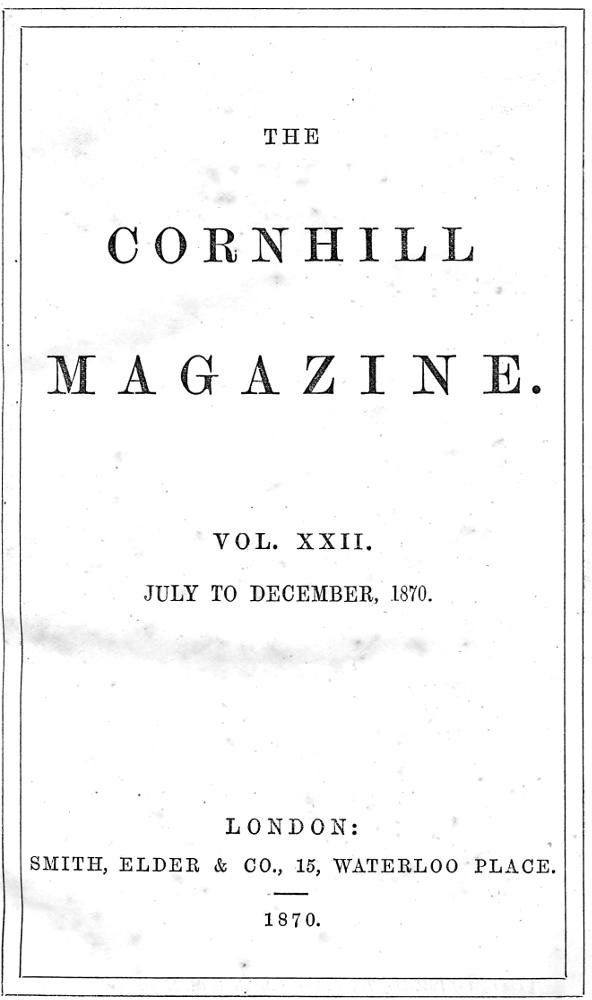

Initial letter I: two young men were seated at breakfast by Sir Luke Fildes; engraver, Swain. Second initial-letter vignette for Charles Lever's Lord Kilgobbin, from the November 1870 number of the Cornhill Magazine, p. 513 in Vol. XXII. 7.3 cm by 5.0 cm (3 by 2 inches), framed. Part 2, Chapter IV, "At 'Trinity'." The wood-engraver responsible for this thumbnail illustration was Joseph Swain (1820-1909), noted for his engravings of Sir John Tenniel's cartoons in Punch. [Click on the image to enlarge it; mouse over links.]
Passage realised for the second vignette: the opening passage in Ch. 4, "At 'Trinity'"
It was while the two young men were seated at breakfast that the post arrived, bringing a number of country newspapers, for which, in one shape or other, Joe Atlee wrote something. Indeed, he was an "own correspondent," dating from London, or Paris, or occasionally from Rome, with an easy freshness and a local colour that vouched for authenticity. These journals were of a very political tint, from emerald green to the deepest orange; and, indeed, between two of them — the Tipperary Pike and the Boyne Water, hailing from Carrickfergus — there was a controversy of such violence and intemperance of language, that it was a curiosity to see the two papers on the same table: the fact being capable of explanation, that they were both written by Joe Atlee — a secret, however, that he had not confided even to his friend Kearney. [Cornhill, Vol. XXII, 512]

Right: The title-page for Volume XXII of the Cornhill Magazine (July-December, 1870).
Luke Fildes has given us a number of representations of the headstrong Kearneys of Kilgobbin: here for a second time (his initial appearance being in The Chums) the illustrator depicts Richard Kearney, twenty-two year-old son and heir of Matthew Kearney, as a child of privilege, a Dublin university student, and thus establishes him as one of the novel's chief characters. The presence of the pro-Catholic and pro-Protestant periodical publications on the table foreshadows one of the novel's chief antipathies. Oddly enough, Fildes presents them in very different fashions to those in which he has depicted them in the full-page illustration for Chapter III.
The two friends are utterly unlike, suggesting the maxim that opposites attract. Their after-breakfast conversation is terminated by the cessation of the ringing of a bell that signals to start of classes; they hastily grab their academic gowns, and exit.
Though such little jarring passages as those we have recorded were nothing uncommon between these two young men, they were very good friends on the whole, the very dissimilarity that provoked their squabbles saving them from any more serious rivalry. In reality, no two people could be less alike: Kearney being a slow, plodding, self-satisfied, dull man, of very ordinary faculties; while the other was an indolent, discursive, sharp-witted fellow, mastering whatever he addressed himself to with ease, but so enamoured of novelty that he rarely went beyond a smattering of anything. He carried away college honours apparently at will, and might, many thought, have won a fellowship with little effort; but his passion was for change. Whatever bore upon the rogueries of letters, the frauds of literature, had an irresistible charm for him; and he once declared that he would almost rather have been Ireland than Shakespeare; and then it was his delight to write Greek versions of a poem that might attach the mark of plagiarism to Tennyson, or show, by a Scandinavian lyric, how the laureate had been poaching from the Northmen. Now it was a mock pastoral in most ecclesiastical Latin that set the whole Church in arms; now a mock despatch of Baron Beust that actually deceived the Revue des Deux Mondes and caused quite a panic at the Tuileries. He had established such relations with foreign journals that he could at any moment command insertion for a paper. . . . [Chapter IV, "At 'Trinity'," 31]
But of course Joe would do so under suitable pseudonyms, demonstrating his command of an astonishing array of European languages. And Dick Kearney hasn't a clue about Joe's subversive journalism, and tends to look down upon his roommate as being great fun, but nbot very intelligent.
Scanned images and text by Philip V. Allingham. [You may use these images without prior permission for any scholarly or educational purpose as long as you (1) credit the person who scanned them and (2) link your document to this URL in a web document or cite the Victorian Web in a print one.]
Bibliography
Lever, Charles. Lord Kilgobbin. The Cornhill Magazine. With 18 full-page illustrations and 18 initial-letter vignettes by S. Luke Fildes. Volumes XXII-XXV. October 1870-March 1872.
Lever, Charles. Lord Kilgobbin: A Tale of Ireland in Our Own Time. With 18 Illustrations by Sir Luke Fildes, R. A. London: Smith, Elder, 1872, 3 vols; rpt., Chapman and Hall, 1873.
Lever, Charles. Lord Kilgobbin. Illustrated by Sir Luke Fildes. Novels and Romances of Charles Lever. Vols. I-III. In three volumes. London: Smith, Elder, 1872, Rpt. London: Chapman & Hall, 1873. Project Gutenberg. Last Updated: 19 August 2010.
Stevenson, Lionel. Chapter XVI, "Exile on the Adriatic, 1867-1872." Dr. Quicksilver: The Life of Charles Lever. New York: Russell and Russell, 1939; rpt. 1969. Pp. 277-296.
Sutherland, John A. "Lord Kilgobbin." The Stanford Companion to Victorian Fiction. Stanford, Cal.: Stanford U. P., 1989, rpt. 1990, 382.
Created 7 June 2023 Updated 10 June 2023